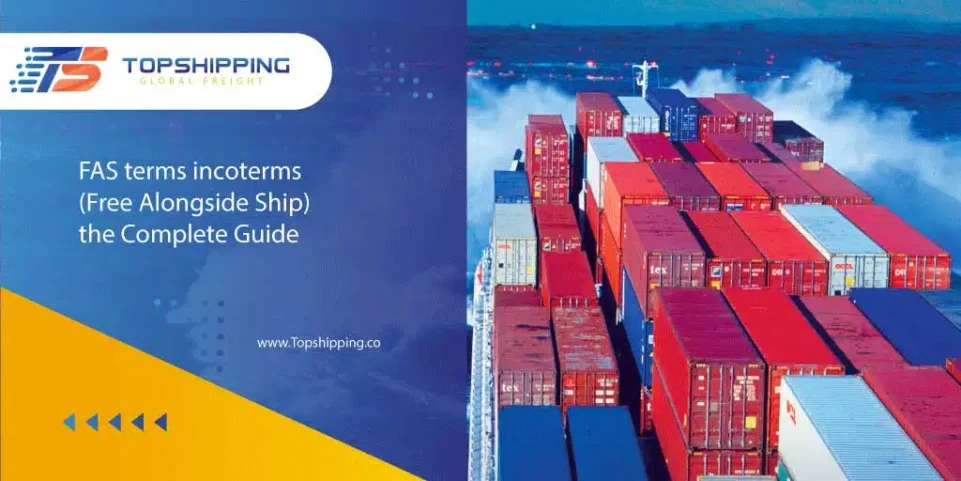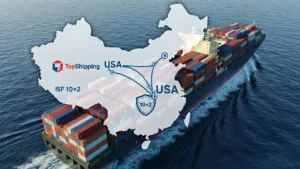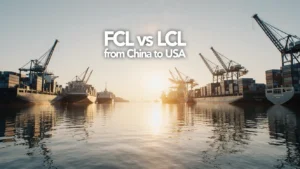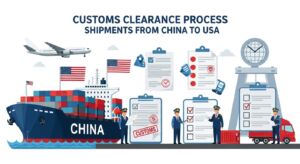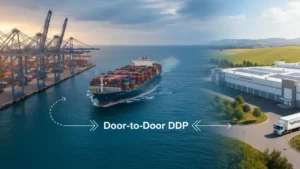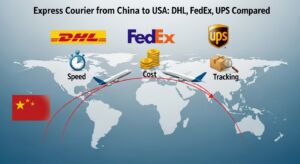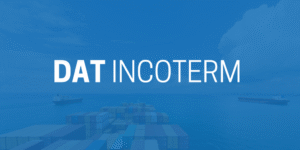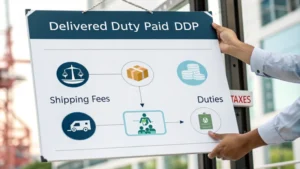Introduction
In the world of global trade, the FAS (Free Alongside Ship) Incoterm often sparks both interest and uncertainty among exporters and importers. Under FAS terms, the seller fulfills their obligation once the goods are placed alongside the vessel at the designated port of shipment. From that moment, all costs, responsibilities, and risks transfer to the buyer — including loading, main carriage, insurance, and delivery.
Although FAS is mainly used for sea freight shipping methods, particularly for bulk and non-containerized cargo, it remains a crucial shipping term for industries like agriculture, minerals, and energy. Understanding which shipping methods are compatible with FAS is essential, as it applies exclusively to maritime transport and cannot be used for air, rail, or road shipments.
Yet, many traders misunderstand how FAS differs from other maritime terms such as FOB (Free on board) or CFR (Cost and Freight), especially regarding risk transfer points and cost allocation.
In this article, we’ll break down the meaning of FAS Incoterms, explain seller and buyer obligations, explore key advantages and limitations, compare FAS with similar Incoterms, and provide practical examples to help you decide when this shipping term — and which shipping method — is the right fit for your trade transactions.
Definition of FAS — Free Alongside Ship
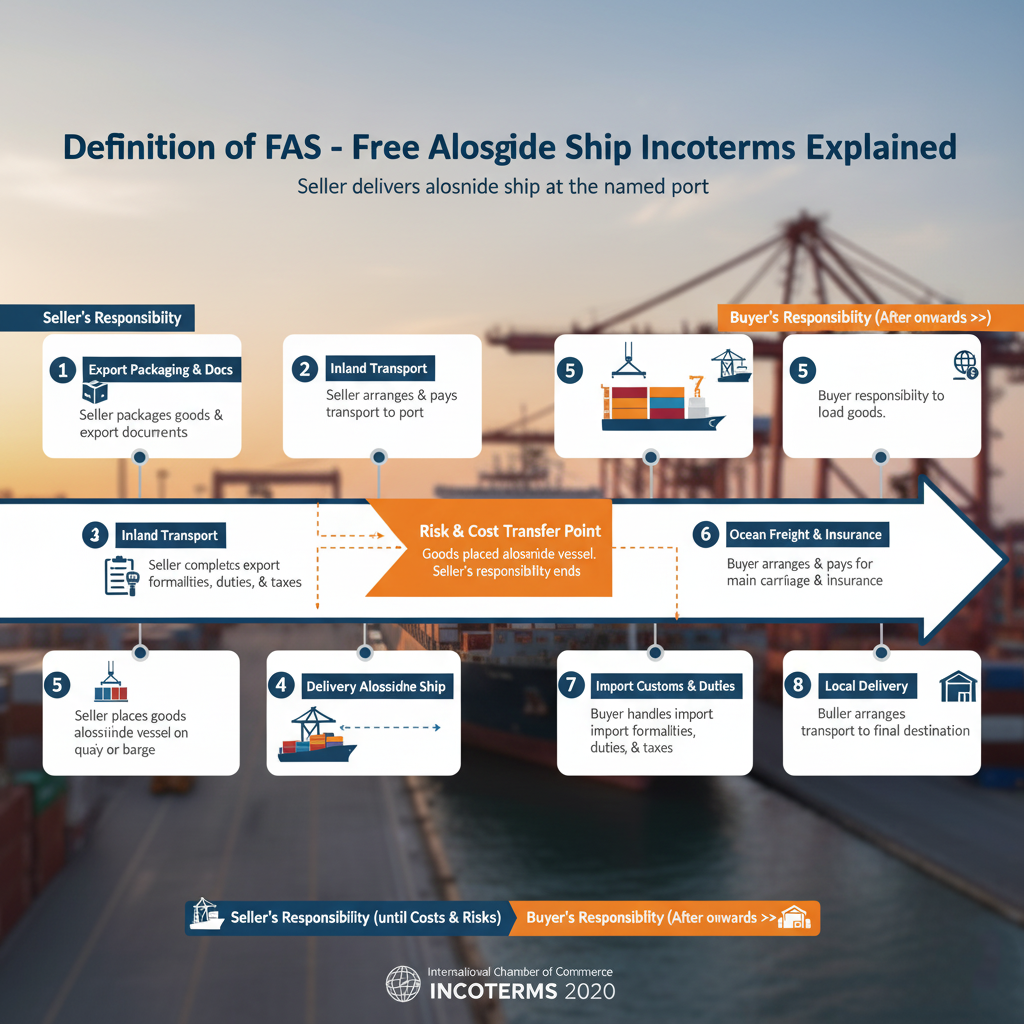
The FAS Incoterm, short for Free Alongside Ship, is one of the key maritime trade terms defined under the Incoterms 2020 rules.
It specifies that the seller is responsible for delivering the goods alongside the ship at the named port of shipment.
Once the goods are placed beside the vessel either on a quay or a barge the risk and cost transfer from the seller to the buyer.
In practical terms, this means that under FAS delivery terms, the seller takes care of export packaging, inland transportation, and export customs clearance.
However, the buyer must handle the cost and risk of loading the goods onto the vessel, as well as arranging and paying for ocean freight, insurance, and import procedures.
The free alongside ship Incoterms rule is particularly suited for bulk or heavy cargo such as raw materials, grain, or minerals where goods are directly delivered next to a vessel rather than in containers.
In such cases, FAS in shipping offers a clear and simple cost division, allowing buyers to manage the main carriage while the seller fulfills obligations at the port of origin.
In essence, FAS free alongside ship represents a transparent agreement: the seller ensures safe delivery up to the ship’s side, and from there, the buyer takes full control of the shipment.
FAS Incoterms 2020: Key Concepts & Why It Matters
The FAS Incoterm 2020 (Free Alongside Ship) defines that the seller’s responsibility ends once the goods are placed alongside the ship at the port of shipment.
From that point, the buyer takes over all costs and risks, including loading, freight, insurance, and import clearance.
These FAS delivery terms are mainly used for bulk or non-containerized goods, giving buyers full control over the main carriage.
The fas incoterm 2020 update clarifies export duties, risk transfer, and documentation, helping traders avoid disputes and plan logistics efficiently.
Understanding the free alongside ship incoterms is essential for anyone in maritime trade offering a clear, fair, and practical division of responsibility between seller and buyer.
When & Where FAS is Used — Suitable Cargo & Shipping Conditions
The FAS Incoterm (Free Alongside Ship) is mainly used in maritime trade for bulk and non containerized cargo such as grain, coal, oil, minerals, or heavy machinery.
Under FAS delivery terms, the seller places the goods alongside the ship at the port, making it ideal for cargo loaded directly by cranes or conveyors.
FAS in shipping is best suited for transactions where the buyer arranges the main carriage, often using chartered or specialized vessels.
FAS Incoterms are less practical for containerized shipments, which are typically handled under FOB or CFR , where the seller’s and buyer’s responsibilities for loading, freight, and risk transfer differ.
Overall, free alongside ship Incoterms offer a simple and transparent choice when goods are moved in bulk and the buyer wants full control over ocean transport and insurance.
Seller’s Obligations under FAS
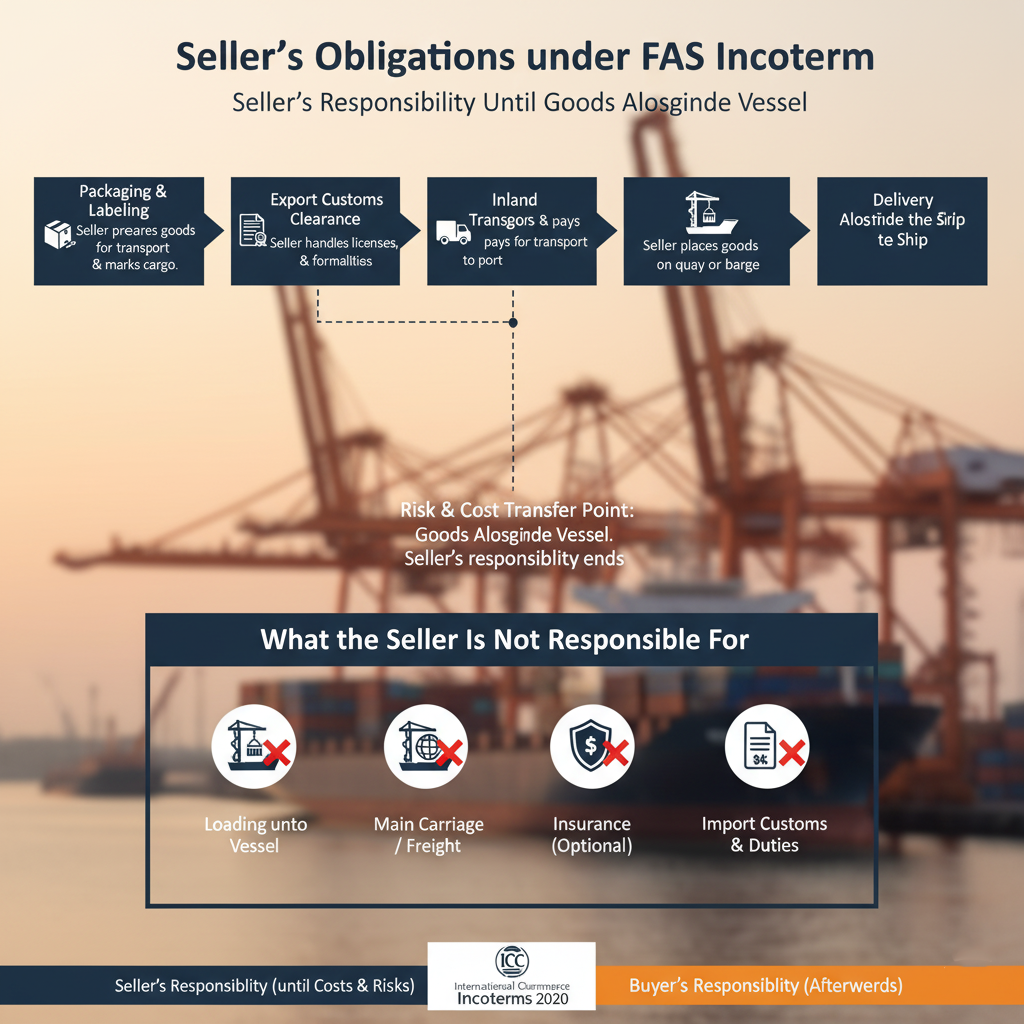
Under the FAS Incoterm (Free Alongside Ship), the seller’s responsibilities are clearly defined and limited to tasks up to the point where the goods are delivered alongside the ship at the named port of shipment. Understanding these obligations is crucial for smooth transactions under FAS shipping terms.
Key Seller Responsibilities
Delivery Alongside the Ship
The seller must ensure that the goods are physically placed alongside the ship, either on the quay, dock, or barge, at the agreed port of shipment. This is the point at which risk transfers from seller to buyer under fas incoterm 2020.
Export Customs Clearance
All necessary export formalities, including licenses, permits, and customs clearance, are the seller’s responsibility. Without proper clearance, the goods cannot be legally delivered alongside ship, potentially causing delays and penalties.
Packaging and Labeling
The seller must package, label, and secure the cargo for safe handling in maritime transport. This includes marking the goods according to international shipping standards to prevent damage during transfer to the vessel.
Provision of Documentation
The seller provides the buyer with required documents, such as the commercial invoice, packing list, and any certificates needed for customs or shipment. These documents enable the buyer to arrange loading, freight, and insurance.
Notification to the Buyer
The seller must inform the buyer when and where the goods are ready for delivery alongside ship so that the buyer can organize transportation and insurance promptly.
What the Seller Is Not Responsible For
- Loading onto the Vessel: Under fas delivery terms, loading is handled by the buyer, including associated costs and risks.
- Main Carriage / Freight: The buyer arranges and pays for ocean or inland waterway transport.
- Insurance: Unlike CIF or CIP, the seller is not obliged to insure the goods beyond the point alongside the ship.
- Import Customs and Duties: All import clearance, taxes, and duties are the buyer’s responsibility.
Practical Example
Suppose a seller in Brazil is shipping bulk coffee to a buyer in Germany under FAS Incoterms 2020. The seller arranges transport to the port of Santos, clears export customs, and delivers the coffee alongside the ship. From that moment, the buyer is responsible for loading the cargo onto the vessel, arranging freight to Germany, obtaining insurance, and clearing import customs.
Buyer’s Obligations under FAS
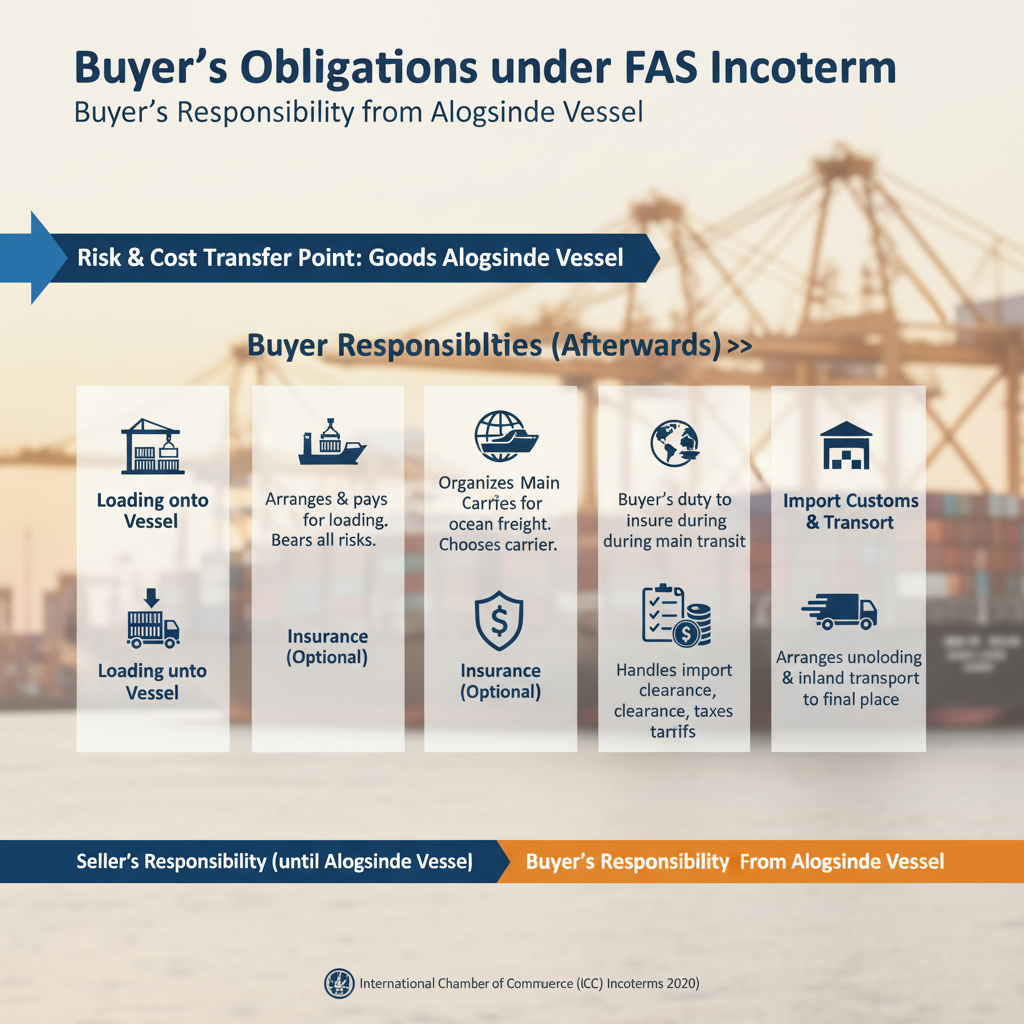
Under the FAS Incoterm (Free Alongside Ship), the buyer assumes responsibility for the goods from the moment they are delivered alongside the ship at the named port of shipment. Understanding these obligations is essential to avoid disputes and ensure smooth maritime trade under FAS shipping terms.
Key Buyer Responsibilities
Loading the Goods onto the Vessel
Once the seller has placed the goods alongside ship, the buyer must arrange for loading onto the vessel. This includes hiring equipment, labor, and supervising the operation. The buyer bears all costs and risks during this stage.
Arranging Main Carriage / Freight
The buyer organizes and pays for the ocean or inland waterway transport from the port of shipment to the destination port. Under fas delivery terms, the buyer has full control over the choice of carrier, route, and schedule.
Insurance
Unlike CIF, under FAS, the buyer is responsible for insuring the goods during the main carriage. Obtaining adequate marine insurance is recommended to protect against damage, loss, or delays.
Import Customs Clearance and Duties
The buyer handles all import formalities, including customs clearance, taxes, tariffs, and any local regulations at the destination port. Proper documentation and compliance are essential to avoid delays.
Additional Handling and Transport
After arrival at the destination port, the buyer arranges unloading, inland transport, and delivery to the final warehouse or facility. All associated costs and risks fall on the buyer.
Practical Example
A buyer in Germany purchases bulk sugar from a seller in Brazil under FAS Incoterms 2020. The seller delivers the sugar alongside the ship at the Port of Santos. From that point, the German buyer is responsible for loading the sugar onto the vessel, arranging ocean freight, insuring the shipment, handling import customs in Germany, and transporting it to their warehouse.
Point of Risk Transfer and Cost Allocation under FAS
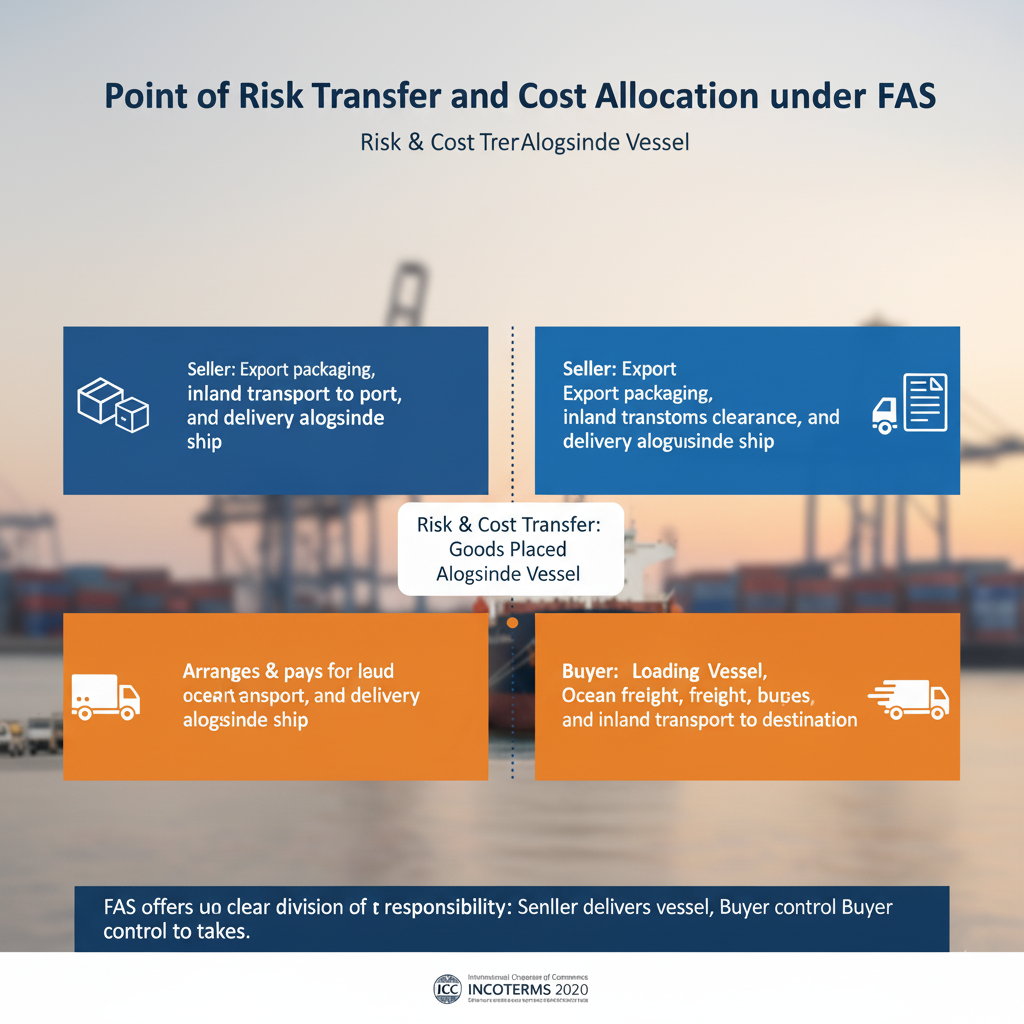
Under the FAS Incoterm 2020 (Free Alongside Ship), risk transfers to the buyer once goods are placed alongside the ship at the named port. Until that point, the seller bears all risks, including damage or loss.
Cost allocation under FAS delivery terms:
- Seller: Export packaging, inland transport to port, export customs clearance, and delivery alongside ship.
- Buyer: Loading onto vessel, ocean freight, insurance, import duties, and inland transport to destination.
FAS in shipping offers a clear division of responsibility: the seller ensures safe delivery beside the vessel, while the buyer controls loading, freight, and insurance.
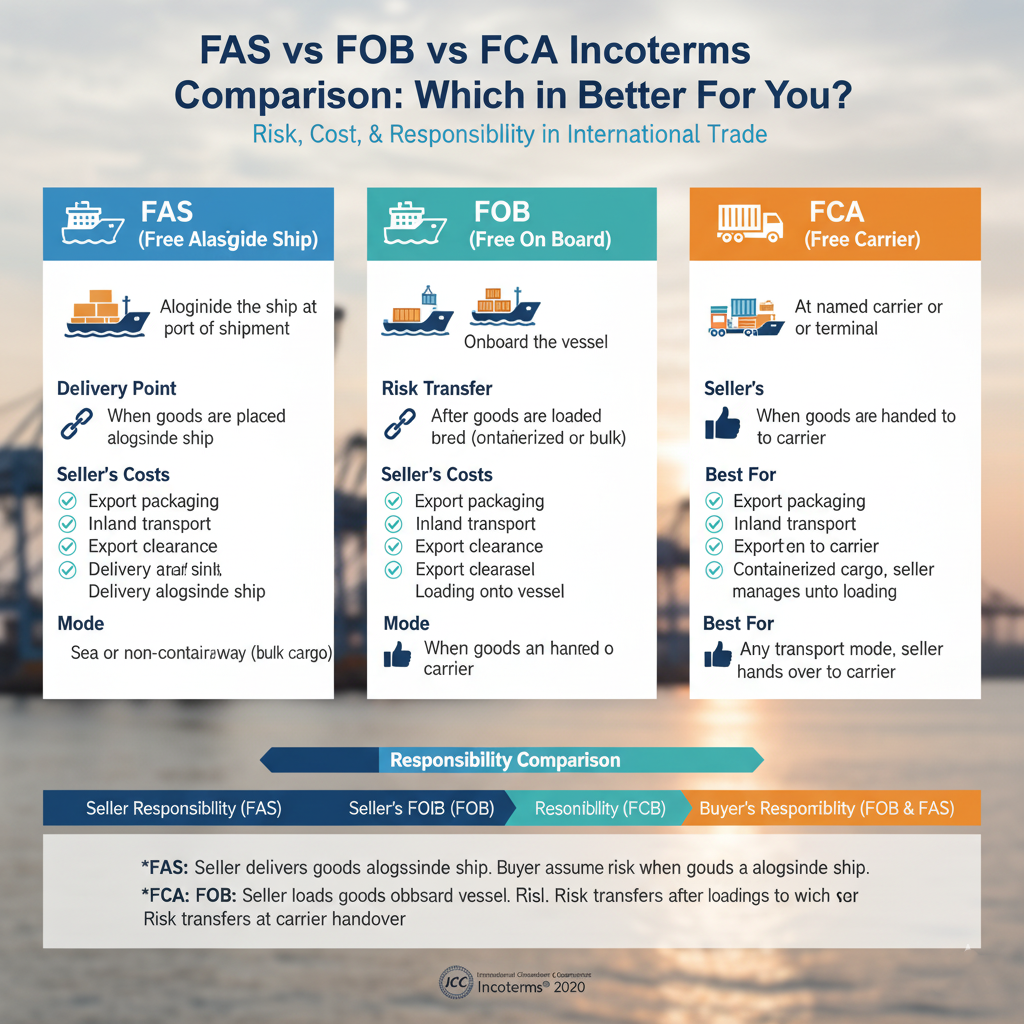
Difference Between FAS vs FOB vs FCA
| Incoterm | Delivery Point | Risk Transfer | Costs Covered by Seller | Mode of Transport |
|---|---|---|---|---|
| FAS (Free Alongside Ship) | Alongside the ship at port of shipment | When goods are placed alongside ship | Export packaging, inland transport to port, export clearance | Sea or inland waterway (bulk cargo) |
| FOB (Free On Board) | Onboard the vessel | After goods are loaded on board | Export packaging, inland transport to port, export clearance, loading onto vessel | Sea or inland waterway (containerized or bulk cargo) |
| FCA (Free Carrier) | At named carrier or terminal | When goods are handed to carrier | Export packaging, inland transport to carrier, export clearance | Any mode of transport (road, rail, sea fright , air) |
Understanding the differences between FAS, FOB, and FCA (Free Carrier) is essential for international maritime trade:
FAS (Free Alongside Ship)
- Seller delivers goods alongside the ship at the port of shipment.
- Buyer is responsible for loading, main carriage, insurance, and import.
- Ideal for bulk or non-containerized cargo.
FOB (Free On Board)
- Seller delivers goods on board the vessel.
- Risk transfers after loading.
- Suitable for containerized cargo where the seller arranges loading onto the ship.
FCA (Free Carrier)
- Seller delivers goods to a carrier or terminal at a named place.
- Can be used for any mode of transport, including road, rail, or air.
- Risk transfers once goods are handed to the carrier, not necessarily at the port.
Key Takeaway:
| Incoterm | Delivery Point | Risk Transfer |
|---|---|---|
| FAS | Seller delivers goods alongside ship | Buyer assumes risk when goods are alongside ship |
| FOB (Free on board ) | Seller loads goods onboard vessel | Risk transfers after loading onto vessel |
| FCA | Seller delivers to carrier or terminal | Risk transfers at carrier handover |
Choosing the right term ensures clear cost allocation, risk transfer, and compliance in international trade.
Insurance under FAS — Is It Required?
Under the FAS Incoterm (Free Alongside Ship), the seller is not required to provide insurance.
Once the goods are delivered alongside the ship at the named port, all risks and responsibilities transfer to the buyer.
This means the buyer must arrange insurance for the main carriage, covering potential damage, loss, or delays during ocean transport.
Unlike CIF or CIP, FAS delivery terms do not include insurance in the seller’s obligations, giving the buyer full control over coverage and cost.
Key Takeaway:
- Seller: delivers goods alongside ship, no insurance required.
- Buyer: responsible for loading, freight, and marine insurance.
Challenges & Limitations of Using FAS
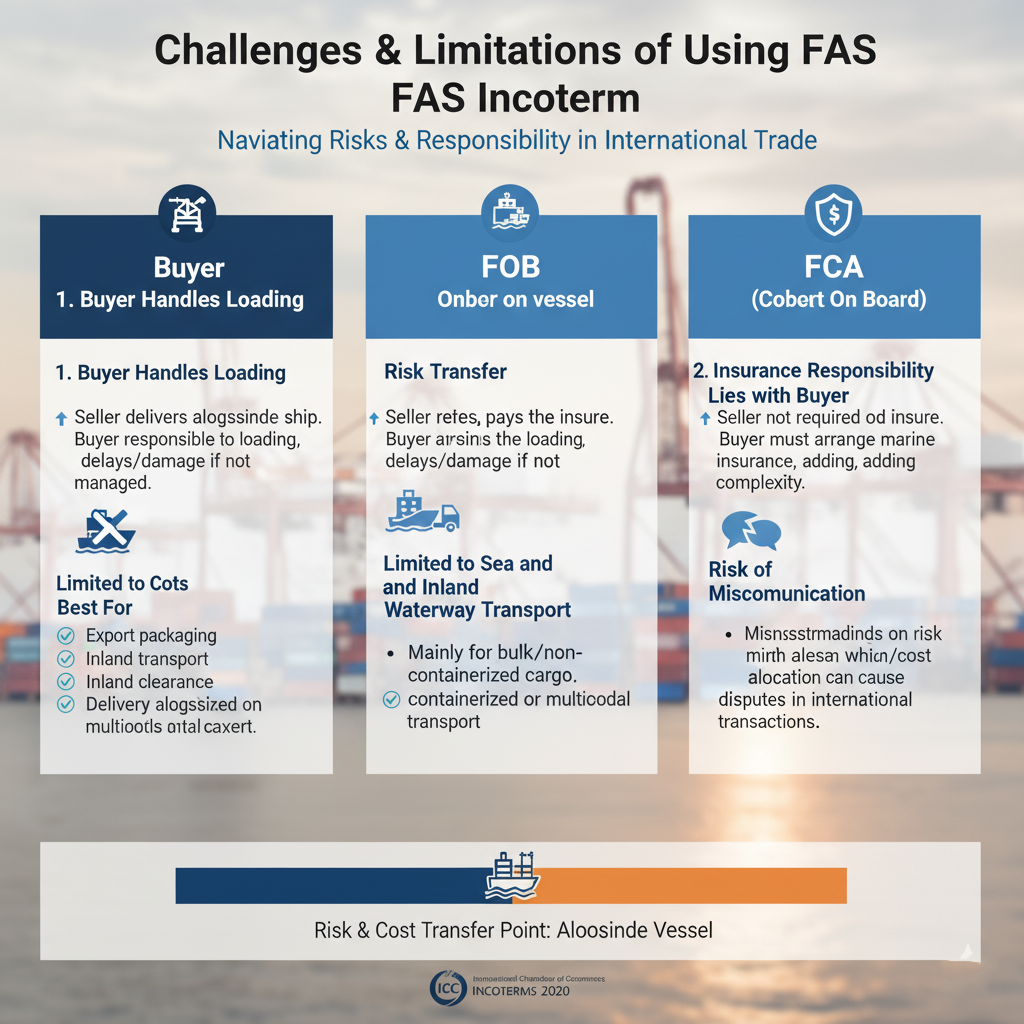
While the FAS Incoterm (Free Alongside Ship) provides clear responsibilities for seller and buyer, it also comes with certain challenges:
Buyer Handles Loading
Since the seller delivers goods only alongside the ship, the buyer is responsible for loading, which can lead to delays or damage if not properly managed.
Insurance Responsibility Lies with Buyer
Unlike CIF, FAS delivery terms do not require the seller to insure the shipment. Buyers must arrange their own marine insurance, which adds complexity.
Limited to Sea and Inland Waterway Transport
FAS in shipping is mainly for bulk or non-containerized cargo. It is less suitable for containerized shipments or multimodal transport.
Risk of Miscommunication
Misunderstanding the point of risk transfer or cost allocation can cause disputes, especially in international transactions.
Practical Example / Scenario: China to USA
A seller in Shanghai, China agrees to sell 50 tons of electronics to a buyer in Los Angeles, USA under FAS Incoterms 2020 at the Port of Shanghai. In this case, the seller’s responsibility ends once the goods are placed alongside the vessel at the designated port. From that point, the buyer takes on all risks and costs associated with shipping from China to the US , including loading, ocean freight, insurance, and inland transportation upon arrival.
Seller’s Responsibilities:
- Transport goods to Shanghai port: $1,500
- Export customs clearance: $400
- Delivery alongside ship: $200
- Total Seller Cost: $2,100
Buyer’s Responsibilities:
- Loading onto the vessel: $300
- Ocean freight to Los Angeles: $3,500
- Marine insurance: $600
- Import customs and duties: $1,200
- Total Buyer Cost: $5,600
Risk Transfer:
Seller bears all risks until the goods are placed alongside ship at Shanghai.
From that point, the buyer assumes all risks, including loading, shipping, insurance, and import.
Key Takeaway:
Buyers in international trade, including shipping from China to the US, gain control over main carriage and insurance under FAS Incoterms, while sellers are responsible for safe delivery alongside the vessel.
Tips for Drafting Clear FAS Clauses in Contracts
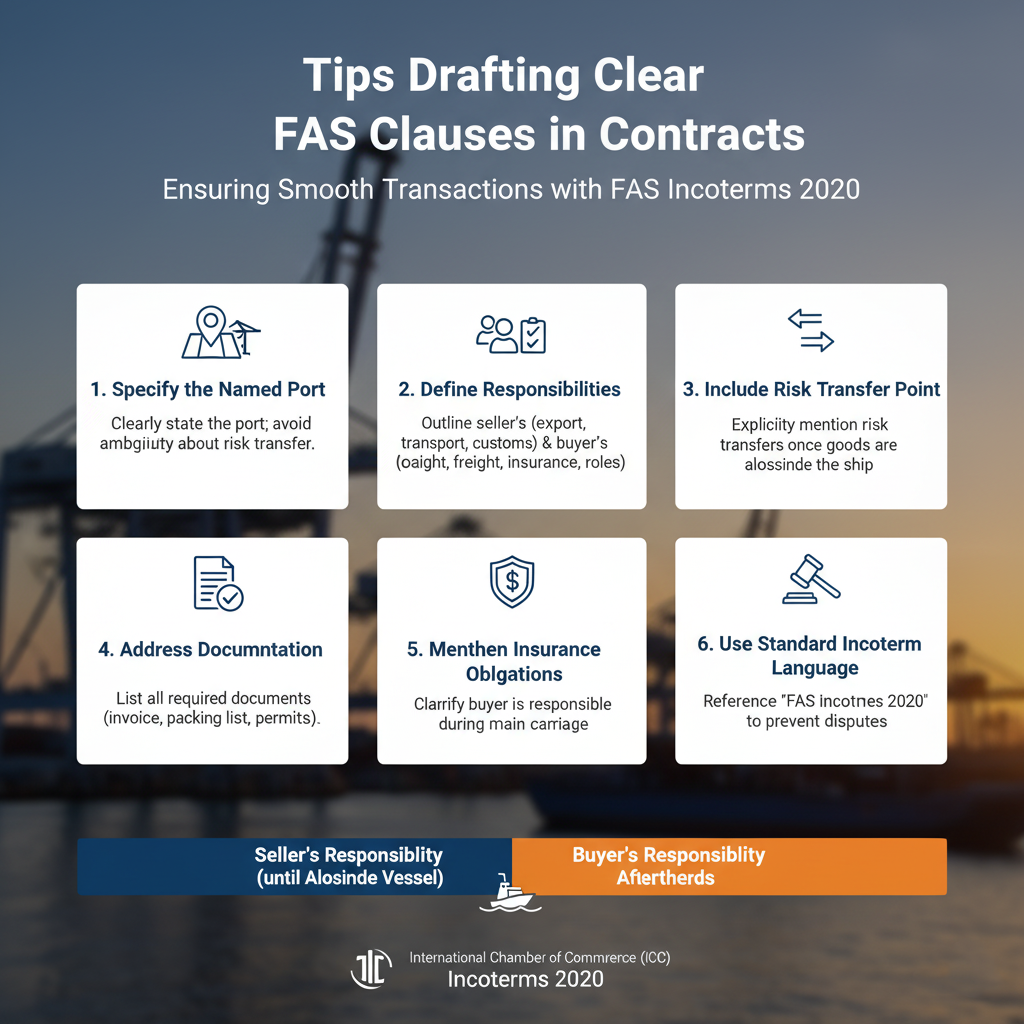
To ensure smooth transactions under FAS Incoterms 2020, it’s essential to draft clear and precise contract clauses. Here are key tips:
Specify the Named Port
Clearly state the port where the seller will deliver goods alongside the ship, avoiding ambiguity about risk transfer.
Define Responsibilities
Outline which costs and obligations fall on the seller (export packaging, transport to port, customs clearance) and which fall on the buyer (loading, freight, insurance, import).
Include Risk Transfer Point
Explicitly mention that risk transfers once goods are alongside the ship, so both parties understand when responsibility shifts.
Address Documentation
List all documents the seller must provide, such as commercial invoice, packing list, and export permits, enabling the buyer to arrange shipment efficiently.
Mention Insurance Obligations
Clarify that the buyer is responsible for insurance during the main carriage, since FAS shipping terms do not include seller provided coverage.
Use Standard Incoterm Language
Reference “FAS Incoterms 2020” or “Free Alongside Ship” in the contract to prevent disputes and align with international standards.
Final Review
The FAS Incoterm (Free Alongside Ship) provides a clear and practical framework for maritime trade, defining responsibilities, risk transfer, and cost allocation between seller and buyer. When used correctly, it ensures transparent operations, minimizes misunderstandings, and gives the buyer control over main carriage and insurance.
Understanding FAS shipping terms also helps businesses plan shipping routes and shipping methods efficiently, especially for bulk or non-containerized cargo, ensuring smoother, risk-managed, and cost-effective international trade.
FAQ FAS incoterm
What is meant by FAS price?
The FAS price is the cost of goods up to the point they are delivered alongside the ship, including export clearance and transport to the port, but excluding loading, freight, and insurance.
What is FAS in contracts?
In contracts, FAS (Free Alongside Ship) specifies that the seller delivers goods beside the vessel at the named port, clearly defining risk transfer, cost allocation, and obligations for both parties.
What is the difference between FOB and FAS delivery terms?
- FAS: seller delivers alongside the ship, buyer loads onto the vessel.
- FOB: seller delivers onboard the vessel, risk transfers after loading.
What does FAS mean in shipping?
In shipping, FAS means the seller’s responsibility ends when goods are delivered alongside the ship, and the buyer takes over all costs and risks for carriage, insurance, and import.
What is a FAS document?
A FAS document is paperwork confirming that the goods have been delivered alongside the ship, often including commercial invoice, packing list, and export clearance documents.
Who pays freight on FAS?
The buyer pays for freight and arranges the main carriage; the seller only covers costs up to delivery alongside the ship.
What does FAS stand for?
FAS stands for Free Alongside Ship, an Incoterm defining seller and buyer responsibilities in maritime trade.
